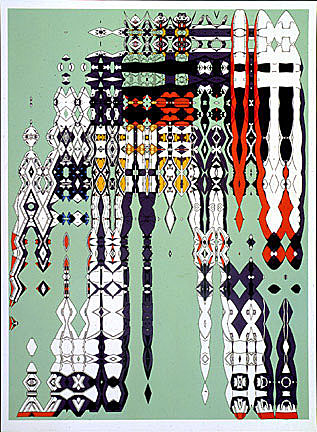

In his review of the New Museum's Brion Gysin exhibit, Artnet critic Ben Davis begrudgingly acknowledges that Gysin has influenced some contemporary artists. But then he works himself into a snit because the museum claims that Gysin isn't just an inspiration but a role model for artists. Attacking the hype is always kind of a greasy strategy when the work is right in front of you. Seizing on the phrase "role model" allows Davis to downplay discussion of what's on display in favor of a lengthy stroll through the artist's life, which Davis finds unsavory for rather priggish-sounding moral reasons, considering that we're talking about a figure who straddled surrealism and the Beats. Davis scolds Gysin in the grave for being overly fond of boys, admiring black people, and showing insufficient commitment to smashing the fascist state in the name of international socialism.
Davis mentions that Gysin's cut-up technique was employed in three William Burroughs books but neglects to mention that they are Burroughs' most important: Naked Lunch, Soft Machine, and The Ticket That Exploded. Pursuing his thesis that Gysin is a lousy role model because his artistic rationales have become quaint, Davis has a good laugh at some ideas of Gysin and/or Burroughs:
--that the "Cut-Up Method" could "free human creativity from what he and Burroughs both called 'Control'-- the soulless rationality of the modern world, the evil specter of normalcy that they saw as their enemy."
--"the Surrealist fascination with madness and altered states of all kinds, and, most problematically, the belief that one could find in an exoticized Primitivism an antidote to suffocating Western middle-class life."
--"the underlying... notion that living a free-spirited bohemian lifestyle is in itself an unthinkable rebellion against the entire system."
Davis presumes to speak for artists in suggesting that none of these motivations matter now. Most don't sound so bad to me, even as snidely phrased by Davis. Davis assumes all artists have reached the same conclusions he has in other writings: that the endless contradictions of reconciling Marxist thought and a market-driven economy have beached everyone in the art world on the same shoals of boredom, paralysis, and repetition of post-post-postmodern ideas.
Well, I have no idea if painter Carl Fudge, whose work is depicted above, considers Brion Gysin a role model but he seems taken enough with the cut-up method to have made a small career out of it, and even made it, dare I say, exciting. Any artist who is using a gridded system to break apart, re-connect, and defamiliarize an image is a Gysin heir, whether the means be scissors and tape or photoshop and jape. There are many of them and my guess is that on some level most of them see art as a valid alternative to the soulless rationality of the modern world.
After my post yesterday bemoaning Davis's dismissive review, Duncan Alexander, aka Hypothete, made some digital cutups of Gysin's cutups that rev the work up to Internet speed. These animated GIFs fuse the strobo-kinesis of the Dream Machine with the slice and dice of the still imagery. Whether the result is a mystical experience or just a seizure is left to the viewer. One complex and seductive take on Gysin filmstrips seems dangerously free-spirited and I hope Davis doesn't find out that artists are doing such things now. It's much more important that we all be whining about "the market" and moaning that there's nothing left to do.
